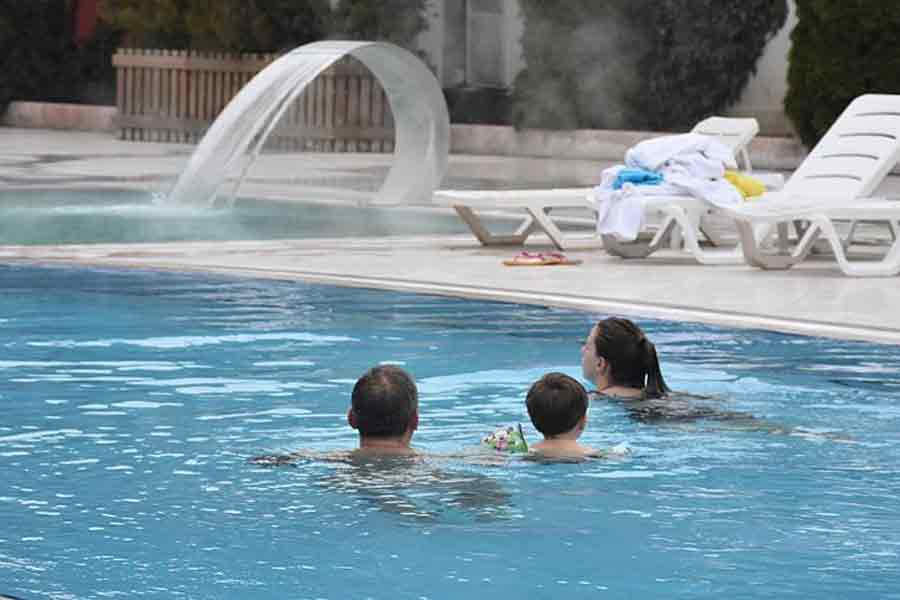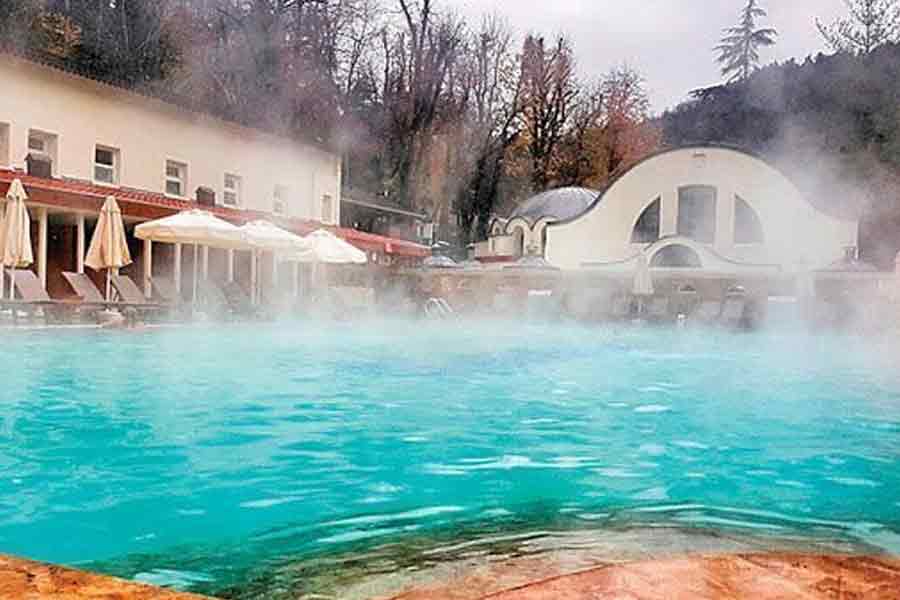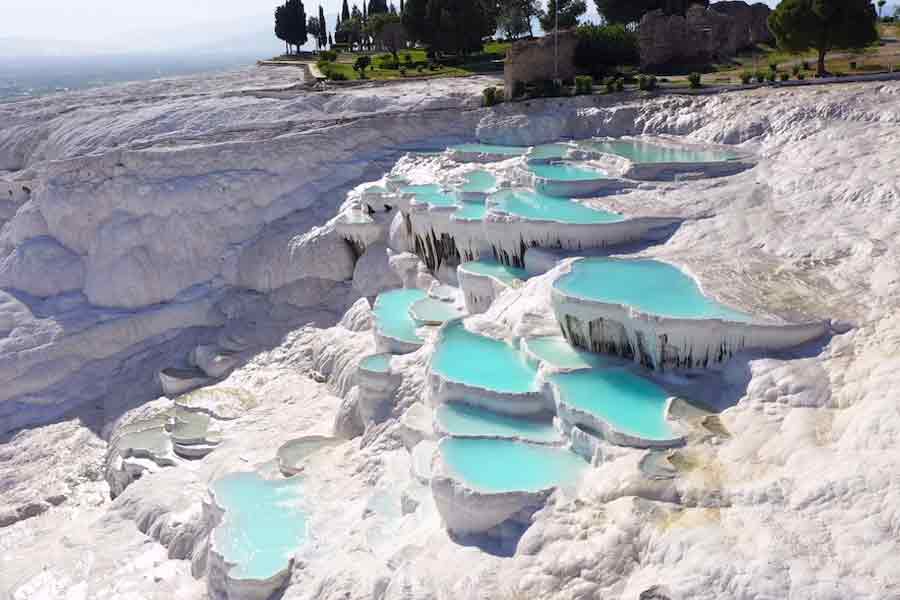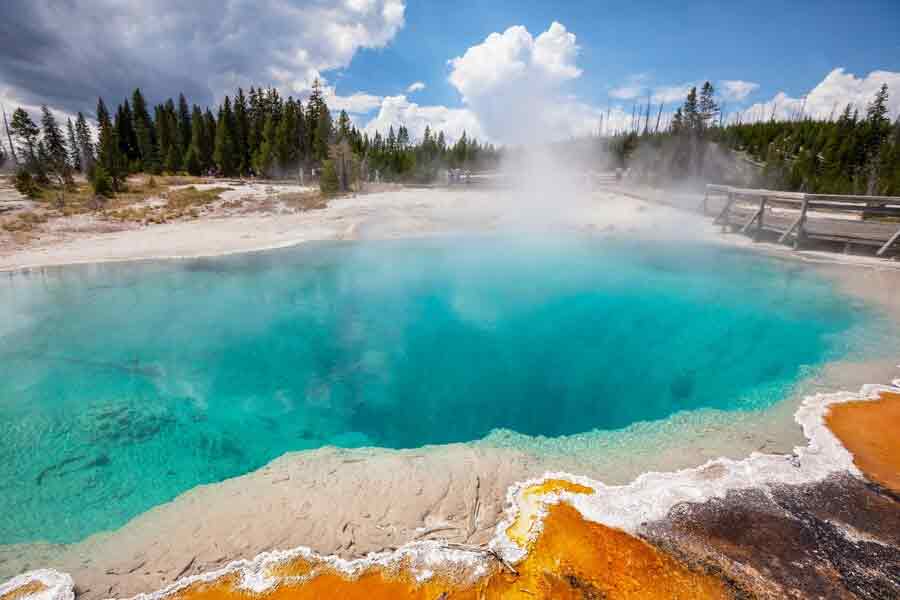Since ancient times, people have been drawn to the hot mineral springs, the healing waters which are at the heart of Europe's spa towns. These places - with their unique urban personalities and a long tradition of welcoming guests - have been centres of health and well-being for centuries, shaping a spa culture that is a unique part of European heritage.
Thermalism can be defined as the therapeutic use of hot springs. Thermalism has been a common practice in Europe from ancient times to the present day. Europe is home to many spa towns with different styles of architecture and an array of spa traditions. This spa culture can truly be considered a unique European heritage.
There are three locations in Türkiye that are part of the European Route of Historic Thermal Towns.
Afyonkarahisar
 Afyonkarahisar is the capital of thermal tourism in Turkey and is animportant center of culture, nature, and gastronomy. Afyonkarahisar has ahistory stretching back more than 5,000 years. It has been home to many empiressuch as those of the Hittites, Phrygians, Romans, Byzantines, Seljuks, and Ottomans. The thermal tradition first took form here in ancient times andwas continued by all societies that lived in the historic city.
Afyonkarahisar is the capital of thermal tourism in Turkey and is animportant center of culture, nature, and gastronomy. Afyonkarahisar has ahistory stretching back more than 5,000 years. It has been home to many empiressuch as those of the Hittites, Phrygians, Romans, Byzantines, Seljuks, and Ottomans. The thermal tradition first took form here in ancient times andwas continued by all societies that lived in the historic city.
Five-star thermal hotels, historical and natural beauties, local cuisine are first things that come into mind when one hears Afyonkarahisar, the center of thermal and health tourism in Turkey.
As one of the key vacationing centers of the western Turkey, Afyonkarahisar attracts attention especially in semester holidays during which the occupancy of the hotels reaches 100 percent.
Its 42 degrees Celsius thermal water offers its visitors a unique experience whole year regardless of the season.
Afyonkarahisar has always been rated as one of the top thermal centers of Turkey with the thermal water and the mineral water - known for its curative effects - in the town of Gazligol in Ihsaniye district; with Omer and Gecek hot springs in Bolvadin district - known to cure many illnesses - and Heybeli Thermal Tourism Center in Bolvadin which dates back to Roman period.
Full of holiday-goers during winter and autumn time, the capital of the thermal tourism welcomes not only local tourists but also foreigners who are attracted by thermal water basin, mud baths, physical therapy and rehabilitation centers in 4 different regions of the city.
Almost 5,000-year-old hot springs of the city cure skin and orthopedic problems, kidney diseases and rheumatism and attract day trippers at the weekends.
1 Million Tourists
With a capacity of 25,000 beds, Afyonkarahisar hosted nearly 1 million local and foreign tourists in 2018.
Besides being a thermal health center, the city also hosts many companies and non-governmental organizations which hold their organizational meetings.
Renowned 2,000-year-old Hudai spring waters in Sandikli district offer mud baths to its local and foreign tourists who search for cure in the cold winter days.
For those who want to benefit the healing effects of mud therapy prefer hot springs in Afyonkarahisar.
The tourists can also visit Afyon Castle and the historical mansions in the same neighborhood.
Mevlevi lodge in Afyonkarahisar is another historical structure, which among 100 Mevlevi lodges in the world, is accepted as the most significant one after Mevlevi lodge in Konya.
Bursa
 Bursa is a modern, popular thermal tourist destination, which featuresmany Turkish baths and hammams. Bursa’s crystal-clear waters are rich inmagnesium, and are known as "Silver Waters." The thermal wateris well-known for treating rheumatic diseases, neuralgia, stressdisorders, sport injuries, and aiding in rehabilitation.
Bursa is a modern, popular thermal tourist destination, which featuresmany Turkish baths and hammams. Bursa’s crystal-clear waters are rich inmagnesium, and are known as "Silver Waters." The thermal wateris well-known for treating rheumatic diseases, neuralgia, stressdisorders, sport injuries, and aiding in rehabilitation.
A member of the European Historic Thermal Towns Association, the province of Bursa hosted the general assembly of the association last year. Bursa, the only province in Turkey that is a member of the European Historic Thermal Towns Association (EHTTA), hosted the general assembly of the association between October 19 and 21. The three-day met welcomed the representatives of 36 cities from 13 countries.
2013 and became a member and policymaker of the association's board in 2015. "Bursa is home to numerous hot springs and public baths inherited from the Roman, Byzantine and Ottoman periods. With its modern thermal facilities, along with its 6,000 bed capacity, Bursa earns the title of being a thermal city, said Karaloğlu.
The Thermal Baths in Bursa and Çekirge
On the west side of Bursa and in the village of Çekirge are hot spring baths containing sulfur and iron, whose fame has spread throughout the East. There are a total of six and the source of all of them is Mt. Olympus. The Large and Small Sulfurous and Yeni and Kaynarca thermal springs contain sulfur and their temperature is more than 80° C. The other two, Eski and Kara Mustafa baths, contain no sulfur and their temperature varies between 38°-57°. All the houses and hotels in Çekirge have hot springs water available.
The sources of the hot springs, known in ancient times as “Basilika,” are very likely remnants of the Roman period when the first construction of the hot springs began. But, all these edifices have-like the Byzantine Empire, vanished. Sultan Murad I had a thermal bath erected in Bursa, with re-used construction materials. Besides the bath, he also had the first mosque constructed on the premises of which his own tomb is located. The baths today are now used mainly by Turks, especially from April to June and in the months of August and September.
Pamukkale
 Pamukkale has been a tourist destination for more than 2,000 years. Pamukkale is not only a natural wonder, but also a place where you can travel back in time by visiting the ancient city of Hierapolis. The ruins of the baths, the temples, and the other monuments of this Graeco-Roman spa resort await visitors today. In Hierapolis, healing waters, superstition, and faith all intermingled in rituals that developed in connection to the successive local cults and religions.
Pamukkale has been a tourist destination for more than 2,000 years. Pamukkale is not only a natural wonder, but also a place where you can travel back in time by visiting the ancient city of Hierapolis. The ruins of the baths, the temples, and the other monuments of this Graeco-Roman spa resort await visitors today. In Hierapolis, healing waters, superstition, and faith all intermingled in rituals that developed in connection to the successive local cults and religions.
Made popular by its glistening calcite travertine terraces, Pamukkale is also well-known for its overflowing, tranquil mineral-rich waters that are said to have healing powers. And as one of the most visited places in Turkey, Pamukkale has made a name for itself as a place to enjoy both Turkish hot springs and a bit of Turkish history.
Hot Springs of Pamukkale
For almost a thousand years, millions have traveled to “soak it up” in the glistening “champagne waters” – all heated by geothermal activity. It has been designated as a UNESCO World Heritage Site putting Pamukkale, rightfully so, on the map as one of the top destinations to visit for its historical value and its beautiful healing mineral pools.
While it might first appear upon arrival people are there to just snag their latest and greatest Instagram post, travelers from near and far are passing through for a quick soak in the mineral-rich springs and Antique Pool.
If dipping your toes in the mineral pools isn’t enough for you, spend the extra 30 Euros and bath in the world-famous Antique Pool. Found within the Hierapolis-Pamukkale grounds the Antique Pool, or rather known as Cleopatra’s Pool, is one the main attractions. As the story goes, the artificially built pool was a gift from Marc Anthony to Cleopatra, herself. In the 7th century, a massive earthquake struck the ancient city, toppling the building and the surrounding Doric columns into the pool.






